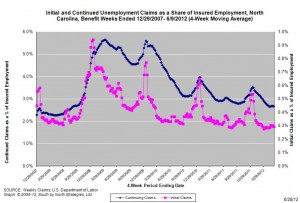29.06.2012
Policy Points
From the Federal Reserve Bank of Richmond’s latest survey of service-sector activity in the South Atlantic (District of Columbia, Maryland, North Carolina, South Carolina, Virginia and West Virginia):
Service sector revenues moved moderately higher in June, according to the latest survey by the Federal Reserve Bank of Richmond. Revenues accelerated at non-retail services firms and big-ticket sales posted solid gains at retail establishments. However, overall retail sales remained anemic and inventories rose as shopper traffic declined. Retailers downgraded their outlook for the rest of 2012, while non-retail services providers remained upbeat.
…
In service sector labor markets, hiring softened overall, weighed down by weakness in retail hiring. Average wage growth strengthened.
…
The overall rate of price change slowed somewhat in June, as acceleration in retail price increases was overshadowed by slower non-retail price growth since May. Survey respondents anticipated that the pace of price change would pick up in the six months ahead.
29.06.2012
Policy Points
A lengthy segment on the PBS program Moyers & Company explores the ways in which “big banks victimize our democracy.” The segment below features a discussion among Bill Moyers, Yves Smith of Naked Capitalism, and Matt Taibbi of Rolling Stone.
28.06.2012
Policy Points
Economic policy reports, blog postings, and media stories of interest:
28.06.2012
Policy Points
For the benefit week ending on June 9, 2012, some 11,164 North Carolinians filed initial claims for state unemployment insurance benefits and 98,769 individuals applied for state-funded continuing benefits. Compared to the prior week, there were fewer initial and fewer continuing claims. These figures come from data released by the U.S. Department of Labor.
Averaging new and continuing claims over a four-week period — a process that helps adjust for seasonal fluctuations and better illustrates trends — shows that an average of 11,035 initial claims were filed over the previous four weeks, along with an average of 100,098 continuing claims. Compared to the previous four-week period, the average number of initial claims was lower, as was the average number of continuing claims.
One year ago, the four-week average for initial claims stood at 11,674, and the four-week average of continuing claims equaled 108,135.
In recent weeks covered employment has increased and now exceeds the level recorded a year ago (3.76 million versus 3.71 million). Nevertheless, there are still fewer covered workers than there were in January 2008, which means that payrolls are smaller today than they were over four years ago.
The graph shows the changes in unemployment insurance claims measured as a share of covered employment in North Carolina since the recession’s start in December 2007. 
Both new and continuing claims appear to have peaked for this cycle, and the four-week averages of new and continuing claims have fallen considerably. Yet continuing claims remain at an elevated level, which suggests that unemployed individuals are finding it difficult to find new positions.
28.06.2012
Policy Points
From the Federal Reserve Bank of Richmond’s latest survey of manufacturing activity in the South Atlantic (District of Columbia, Maryland, North Carolina, South Carolina, Virginia and West Virginia):
Manufacturing activity in the central Atlantic region softened in June, following six months of moderate expansion, according to the Richmond Fed’s latest survey. Looking at the main components of activity, shipments edged into negative territory as growth in new orders experienced notable declines and employment grew at a rate well below May’s pace. Most other indicators also suggested weakening activity. District contacts reported that capacity utilization and vendor lead-time turned negative, while growth in order backlogs exhibited marked weakness. Manufacturers reported that finished goods inventories grew at a much quicker pace, while raw materials were nearly unchanged.
…
Despite the moderation in recent activity, assessments of business prospects for the next six months were in line with last month’s readings. Contacts at more firms anticipated that shipments, new orders, backlogs, capacity utilization and capital expenditures would grow at a solid pace.


 Email Sign-Up
Email Sign-Up RSS Feed
RSS Feed